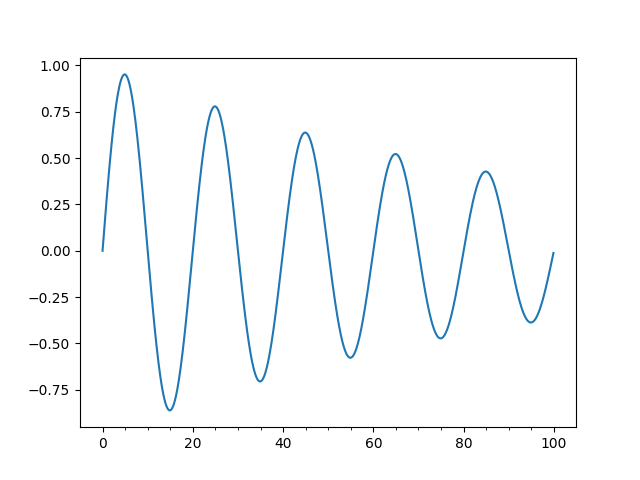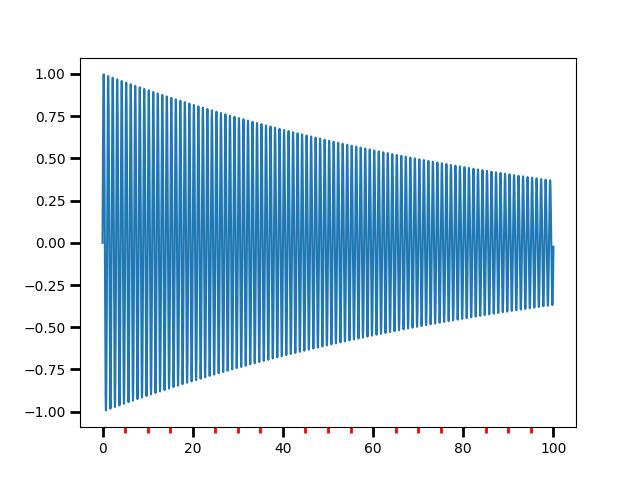笔记
单击此处 下载完整的示例代码
主要和次要刻度#
演示如何使用主要和次要代码。
两个相关的类是Locators 和Formatters。定位器确定刻度线的位置,格式化程序控制刻度线标签的格式。
默认情况下,次要刻度是关闭的(使用NullLocator和NullFormatter)。通过设置次要定位器,可以在没有标签的情况下打开次要刻度。可以通过设置次要格式化程序来打开次要刻度标签。
MultipleLocator将刻度放在某个基数的倍数上。
StrMethodFormatter使用格式字符串(例如,'{x:d}'或'{x:1.2f}'
或)来格式化刻度标签(格式字符串中的变量必须是)。对于 a ,字符串可以直接传递给or
。一个适当的将被自动创建和使用。'{x:1.1f} cm''x'StrMethodFormatterAxis.set_major_formatterAxis.set_minor_formatterStrMethodFormatter
pyplot.grid一起更改 y 和 y 轴的主要刻度的网格设置。如果要控制给定轴的次要刻度的网格,例如使用
ax.xaxis.grid(True, which='minor')
请注意,给定的定位器或格式化程序实例只能在单个轴上使用(因为定位器存储对轴数据和视图限制的引用)。
import matplotlib.pyplot as plt
import numpy as np
from matplotlib.ticker import (MultipleLocator, AutoMinorLocator)
t = np.arange(0.0, 100.0, 0.1)
s = np.sin(0.1 * np.pi * t) * np.exp(-t * 0.01)
fig, ax = plt.subplots()
ax.plot(t, s)
# Make a plot with major ticks that are multiples of 20 and minor ticks that
# are multiples of 5. Label major ticks with '.0f' formatting but don't label
# minor ticks. The string is used directly, the `StrMethodFormatter` is
# created automatically.
ax.xaxis.set_major_locator(MultipleLocator(20))
ax.xaxis.set_major_formatter('{x:.0f}')
# For the minor ticks, use no labels; default NullFormatter.
ax.xaxis.set_minor_locator(MultipleLocator(5))
plt.show()

主要和次要刻度的自动刻度选择。
使用交互式平移和缩放来查看刻度间隔如何变化。每个主要间隔将有 4 或 5 个次要刻度间隔,具体取决于主要间隔。
可以提供一个参数来AutoMinorLocator指定每个主要间隔的固定数量的次要间隔,例如AutoMinorLocator(2)将导致主要刻度之间的单个次要刻度。
t = np.arange(0.0, 100.0, 0.01)
s = np.sin(2 * np.pi * t) * np.exp(-t * 0.01)
fig, ax = plt.subplots()
ax.plot(t, s)
ax.xaxis.set_minor_locator(AutoMinorLocator())
ax.tick_params(which='both', width=2)
ax.tick_params(which='major', length=7)
ax.tick_params(which='minor', length=4, color='r')
plt.show()

参考
此示例中显示了以下函数、方法、类和模块的使用:
脚本总运行时间:(0分1.333秒)